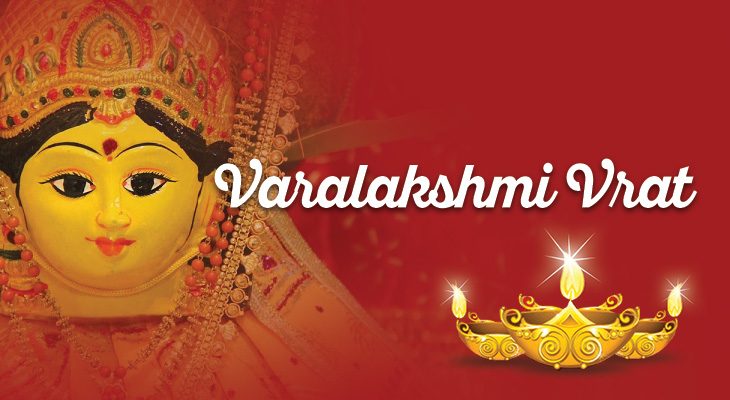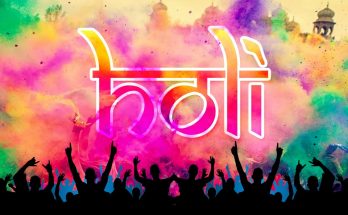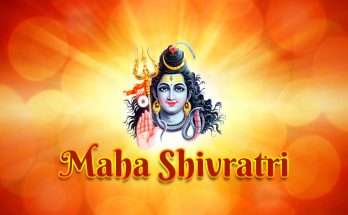Varalakshmi Pooja
This Vrat falls in the holy month of Shravan on the first Friday before the Pournami or Poornima (the full moon day), corresponding to July – August. This time, Varalakshmi Puja falls on the 31st of July 2020.
Mantra to invoke the blessings of Goddess Lakshmi on the day of Varalakshmi Vrat
|| Om Hreem Shreem Lakshmibhayo Namah ||
Varalakshmi Vratam on Friday, July 31, 2020
Simha Lagna Puja Muhurat (morning) – 07:28 AM to 09:36 AM
Duration – 02 Hours 08 Mins
Vrishchika Lagna Puja Muhurat (afternoon) – 01:54 PM to 04:08 PM
Duration – 02 Hours 14 Mins
Kumbha Lagna Puja Muhurat (evening) – 08:04 PM to 09:40 PM
Duration – 01 Hour 37 Mins
Vrishabha Lagna Puja Muhurat (midnight) – 12:58 AM to 02:58 AM, Aug 01
Duration – 02 Hours 00 Mins
To understand how this Vrat comes into being, let us take a peep in Hindu mythology.
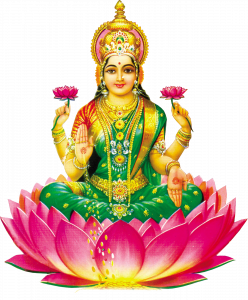 According to Skanda Purana, Goddess Parvathi asks Lord Shiva about a Vrat/fast that would prove to be favourable for women, which would help her lead a happy and prosperous life on earth. Lord Shiva mentions the importance of Varalakshmi Vrat. To illustrate the importance of the Varalakshmi Vrat, Lord Shiva narrated the story of Charumati.
According to Skanda Purana, Goddess Parvathi asks Lord Shiva about a Vrat/fast that would prove to be favourable for women, which would help her lead a happy and prosperous life on earth. Lord Shiva mentions the importance of Varalakshmi Vrat. To illustrate the importance of the Varalakshmi Vrat, Lord Shiva narrated the story of Charumati.
In a beautiful town called Kundinagaram located in the Kingdom of Vidarbha, there lived Charumathi, a true pativrata (devoted to husband in all sincerity). Being pleased by her devotion, Goddess Adilakshmi appears in a dream and asks her to perform the Vrat for the fulfillment of desires. Charumathi immediately wakes up from her dream and tells her husband about it. She then along with some neighbourhood women prepare for the ritual by beginning with a bath in the wee hours of dawn, preparing a mandapam and inviting Varalakshmi Devi. She wears nine threads Thoranam on the right hand and offers naivadyam to Goddess Lakshmi Devi. When Charumati and her friends performed the Vrat, they were showered with riches following the completion of each pradakshina. Following this event, Varalakshmi Vrat became an annual event in many households and since then, Hindu women perform this Vrat with utmost faith and trust until today.
Another popular story would be:
King Bathrasiravas and Queen Surachandrika were blessed with a daughter named Shyamabala. She got married to the prince of a neighbouring kingdom. Once while at her parents’ palace, Shyamabala witnessed her mother driving away from an old lady. It so seemed that the old lady had asked the Queen to perform Varalakshmi Pooja. The queen drove her out, not liking the idea of a beggar advising her regarding the Pooja. Instead, the kind-hearted Shyamabala invited the old lady in and listened to the greatness of Varalakshmi Vrata. Upon returning to her country, she performed the Vrata as directed by the old lady. Prosperity started seeping in with immediate effect and the Prince was appreciated for his administration. However, her parents had to undergo numerous troubles and there was suffering all around. All wealth was lost and the people started revolting against the rule of the King and the Queen. Shyamabala had sent pots of gold when she heard about the bad times that befell her parent’s kingdom. But Alas! That gold turned into ashes the moment her mother set eyes on it. Upon hearing this incident, Shyamabala realized that the old woman was Goddess Lakshmi in disguise and all this was the result of her mother driving out the old woman from the palace. Shyamabala requested her mother to ask for forgiveness from Goddess Lakshmi and perform the Varalakshmi Vrata. The queen did so and everything was restored back to its former glory.
Yet another story would be:
Once upon a time Lord Shiva and Goddess Parvathi were playing a game of dice. There was a dispute on who won. Both of them claimed that they won the game. So they decided to consult Chitranemi, a gana of Lord Shiva who would give an unbiased testimony regarding the winner. Chitramani confirmed that Lord Shiva won the dance which in turn angered Goddess Parvathi. Accusing him of lying, she cursed Chitranemi to be born on earth as a leper. Lord Shiva pleads for Chitranemi, claiming that he is honest. Parvathi finally concedes to revoke the curse provided, he watched celestial apsaras perform Varalakshmi Vrat on the banks of holy waters. One day Chitranemi met a group of celestial apsaras who were performing Varalakshmi Vrat puja. With great devotion, he participated in the puja, was cured of leprosy and became a normal person again.
Chanting Mantras
Padmasane Padmakarey Sarvalokaika Poojithe
Narayana Priaye Devi, Supreetaa Bhavasarvadaa
Shodhashopachara Pooja Prarambhaha…
Performing the Pooja:
- Men and women can perform the Vrat, but generally, it is the women of the family who take up the fast, to invoke the blessings of the Goddess for the well-being of the family.
- On this auspicious day of the puja, women wake up early in the morning, keep a ritualistic fast which differ from region to region, clean the puja room/place and make a kolam (rangoli) with rice flour.
Varalakshmi Pooja Decoration:
- A mandapam/small wooden platform is placed and a cup of rice is spread on the mandapam.
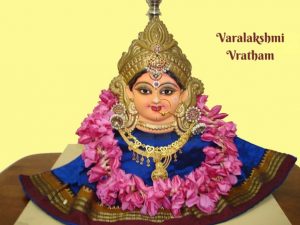
- A Kalash/pot is wrapped and decorated with a saree. A swastika symbol is drawn with a mixture of kumkum and sandalwood paste. It varies from region to region as to what the Kalash would be partially filled with, which includes holy water from any river and/or rice, coins, five different kinds of leaves, beetle nut, turmeric, comb, mirror, small black bangles, and black beads.
- The Kalash is sometimes covered with cloth up to the neck and mango leaves are placed on the mouth of the Kalash.
- A coconut is then placed on top of the Kalash, smeared all over with turmeric powder and a kumkum tilak.
- The Kalash, now symbolically representing Goddess Lakshmi is further decorated with gold ornaments and fresh flowers. This Kalash is then placed on the bed of rice. From now on, the Kalash is called and worshipped as a Devi.
- Sweets and flowers placed in front of the Goddess are known as Vayana.
- The puja starts with first worshipping Ganesh followed by the Varalakshmi puja.
The Varalakshmi puja includes Kalash puja, Archana, Ashtothra puja and Kanakana puja. Ladieswear the kankanam (yellow thread) on their right-hand wrist.
In some regions, after worship, a Thamboolam comprising of a betel leaf (Paan ka Patta), areca nut (supari), slaked lime, turmeric, gold coin or currency, blouse piece, and flowers are given as takeaways to married women who in turn bless the household that performed the puja. The items gifted may vary from region to region. In some regions, the fast is carried out only till the puja period.
In certain other regions, after the puja, an aarthi is offered to the Goddess in the evening. The following day, the water from the Kalash is sprinkled around the house. If rice grains were one of the components in the Kalash, then that would be used as Prasad or a rice meal for the next day.
Significance:
Varalakshmi Pooja is a popular ritual observed by married women in states of Karnataka, Tamil Nadu, and Andhra Pradesh, done to please Goddess Lakshmi, the consort of Lord Vishnu. This Vrat has been imbibed in, with a lot of devotion and dedication by the married women for good progeny, good health, and praying for their husbands’ longevity. Varalakshmi means “the boon granting goddess.” Worshipping Goddess Lakshmi on this auspicious day is equivalent to worshipping Ashtalakshmi – the Eight Goddesses of Wealth, Earth, Learning, Love, Fame, Peace, Pleasure, and Strength.
Previous: Nag Panchami 2019



